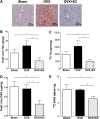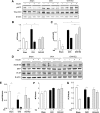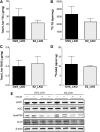Estrogen treatment after ovariectomy protects against fatty liver and may improve pathway-selective insulin resistance
- PMID: 22966069
- PMCID: PMC3554377
- DOI: 10.2337/db11-1718
Estrogen treatment after ovariectomy protects against fatty liver and may improve pathway-selective insulin resistance
Abstract
Pathway-selective insulin resistance where insulin fails to suppress hepatic glucose production but promotes liver fat storage may underlie glucose and lipid abnormalities after menopause. We tested the mechanisms by which estrogen treatment may alter the impact of a high-fat diet (HFD) when given at the time of ovariectomy (OVX) in mice. Female C57BL/6J mice underwent sham operation, OVX, or OVX with estradiol (E2) treatment and were fed an HFD. Hyperinsulinemic-euglycemic clamps were used to assess insulin sensitivity, tracer incorporation into hepatic lipids, and liver triglyceride export. OVX mice had increased adiposity that was prevented with E2 at the time of OVX. E2 treatment increased insulin sensitivity with OVX and HFD. In sham and OVX mice, HFD feeding induced fatty liver, and insulin reduced hepatic apoB100 and liver triglyceride export. E2 treatment reduced liver lipid deposition and prevented the decrease in liver triglyceride export during hyperinsulinemia. In mice lacking the liver estrogen receptor α, E2 after OVX limited adiposity but failed to improve insulin sensitivity, to limit liver lipid deposition, and to prevent insulin suppression of liver triglyceride export. In conclusion, estrogen treatment may reverse aspects of pathway-selective insulin resistance by promoting insulin action on glucose metabolism but limiting hepatic lipid deposition.
Figures







Similar articles
-
Cellular mechanism by which estradiol protects female ovariectomized mice from high-fat diet-induced hepatic and muscle insulin resistance.Endocrinology. 2013 Mar;154(3):1021-8. doi: 10.1210/en.2012-1989. Epub 2013 Jan 30. Endocrinology. 2013. PMID: 23364948 Free PMC article.
-
Chronic angiotensin AT2R activation prevents high-fat diet-induced adiposity and obesity in female mice independent of estrogen.Metabolism. 2015 Jul;64(7):814-25. doi: 10.1016/j.metabol.2015.01.019. Epub 2015 Mar 14. Metabolism. 2015. PMID: 25869303 Free PMC article.
-
Estradiol treatment or modest exercise improves hepatic health and mitochondrial outcomes in female mice following ovariectomy.Am J Physiol Endocrinol Metab. 2021 Jun 1;320(6):E1020-E1031. doi: 10.1152/ajpendo.00013.2021. Epub 2021 Apr 19. Am J Physiol Endocrinol Metab. 2021. PMID: 33870713 Free PMC article.
-
Congenital adiponectin deficiency mitigates high-fat-diet-induced obesity in gonadally intact male and female, but not in ovariectomized mice.Sci Rep. 2022 Oct 5;12(1):16668. doi: 10.1038/s41598-022-21228-x. Sci Rep. 2022. PMID: 36198723 Free PMC article.
-
Estrogen signaling prevents diet-induced hepatic insulin resistance in male mice with obesity.Am J Physiol Endocrinol Metab. 2014 May 15;306(10):E1188-97. doi: 10.1152/ajpendo.00579.2013. Epub 2014 Apr 1. Am J Physiol Endocrinol Metab. 2014. PMID: 24691030 Free PMC article.
Cited by
-
Estrogen and n-3 polyunsaturated fatty acid supplementation have a synergistic hypotriglyceridemic effect in ovariectomized rats.Genes Nutr. 2015 Jul;10(4):475. doi: 10.1007/s12263-015-0475-1. Epub 2015 Jun 25. Genes Nutr. 2015. PMID: 26109183 Free PMC article.
-
Blueberries improve glucose tolerance without altering body composition in obese postmenopausal mice.Obesity (Silver Spring). 2015 Mar;23(3):573-80. doi: 10.1002/oby.20926. Epub 2015 Jan 22. Obesity (Silver Spring). 2015. PMID: 25611327 Free PMC article.
-
Insight into genetic, biological, and environmental determinants of sexual-dimorphism in type 2 diabetes and glucose-related traits.Front Cardiovasc Med. 2022 Nov 24;9:964743. doi: 10.3389/fcvm.2022.964743. eCollection 2022. Front Cardiovasc Med. 2022. PMID: 36505380 Free PMC article. Review.
-
Estrogen Improves Insulin Sensitivity and Suppresses Gluconeogenesis via the Transcription Factor Foxo1.Diabetes. 2019 Feb;68(2):291-304. doi: 10.2337/db18-0638. Epub 2018 Nov 28. Diabetes. 2019. PMID: 30487265 Free PMC article.
-
The interplay between diabetes mellitus and menopause: clinical implications.Nat Rev Endocrinol. 2022 Oct;18(10):608-622. doi: 10.1038/s41574-022-00708-0. Epub 2022 Jul 7. Nat Rev Endocrinol. 2022. PMID: 35798847 Review.
References
Publication types
MeSH terms
Substances
Grants and funding
LinkOut - more resources
Full Text Sources
Molecular Biology Databases

